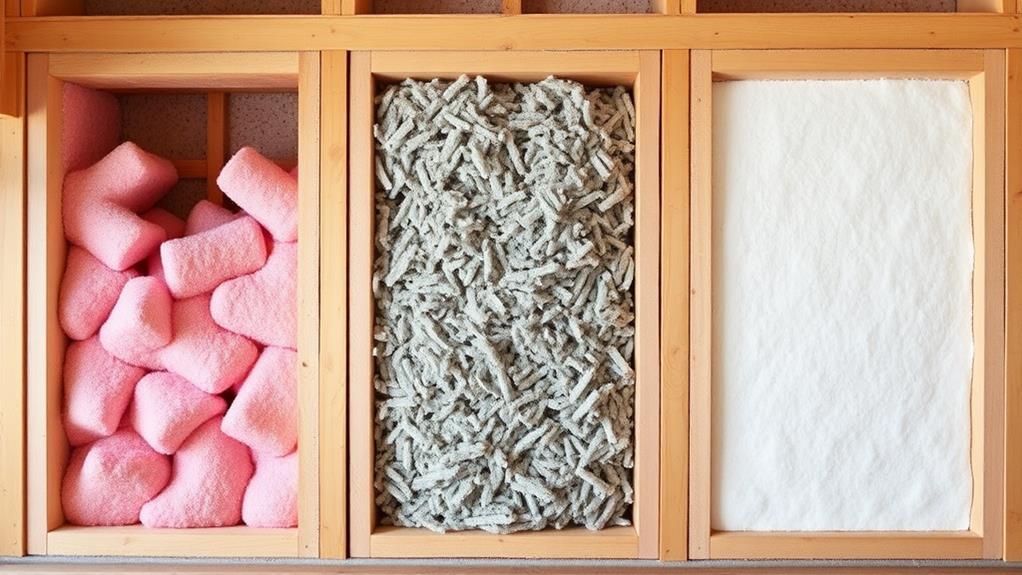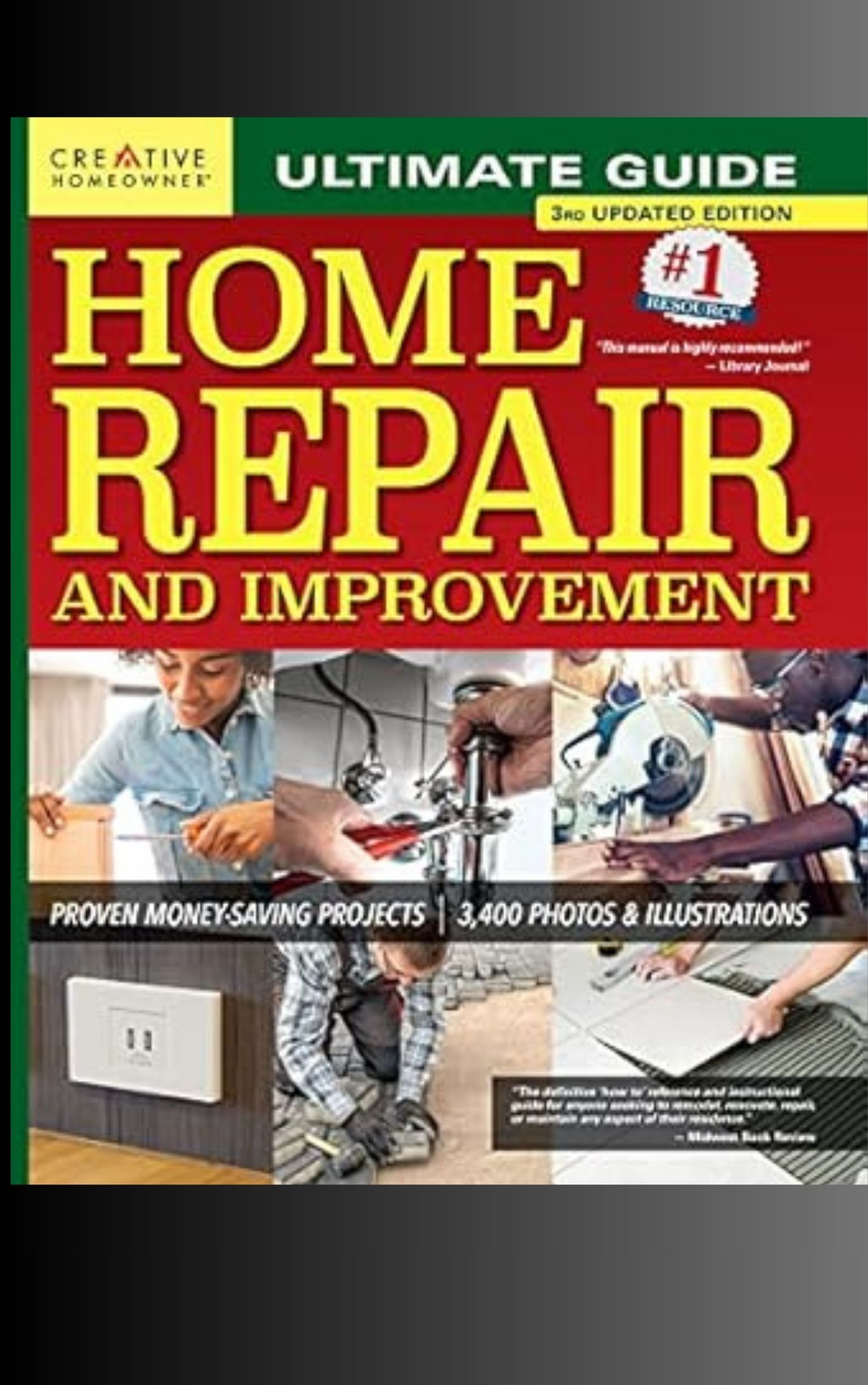When choosing wall insulation, you'll typically consider fiberglass, cellulose, and spray foam options. Fiberglass is the most affordable, offering R-values of 2.2-2.7 per inch. Cellulose, made from recycled materials, provides better sound dampening and slightly higher R-values of 3.1-3.8 per inch. Spray foam offers superior air sealing and moisture control, with R-values of 3.6-3.8 for open-cell and 6.0-7.0 for closed-cell types. Each option has unique installation methods, environmental impacts, and long-term cost implications. Your choice will depend on your budget, energy efficiency goals, and specific home requirements. Understanding the pros and cons of each type will help you make an informed decision.
Understanding Fiberglass Insulation
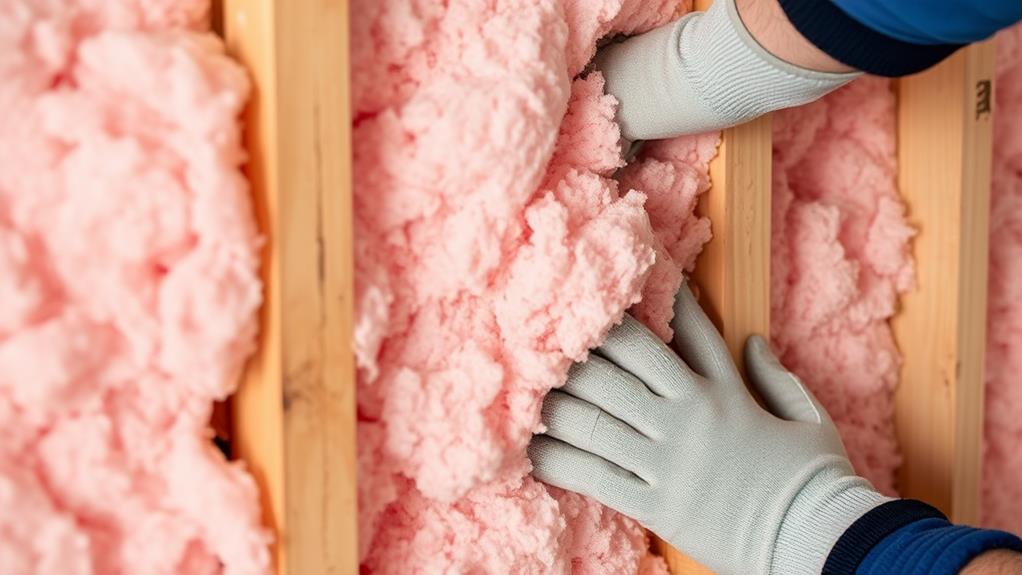
In light of its popularity and effectiveness, fiberglass insulation remains a top choice for many homeowners. It's made from fine glass fibers and comes in two main forms: batts and loose-fill. Batts are pre-cut panels that fit between wall studs, while loose-fill is blown into cavities using special equipment.
Fiberglass insulation works by trapping air pockets within its fibers, slowing heat transfer. It's relatively inexpensive, easy to install, and widely available. You'll find it has an R-value ranging from R-2.2 to R-2.7 per inch, making it effective for most climates.
When installing fiberglass, you'll need to wear protective gear, as the fibers can irritate your skin and lungs. Proper installation is crucial to maximize its performance. Gaps or compression can significantly reduce its effectiveness.
One drawback of fiberglass is that it can absorb moisture, which may lead to mold growth and reduced insulating properties. It's also not as effective in extreme temperatures compared to some alternatives. However, with proper installation and moisture control, fiberglass insulation can provide reliable thermal performance for your walls at a reasonable cost.
The Benefits of Cellulose Insulation
Exploring cellulose insulation reveals several key benefits for homeowners seeking an eco-friendly alternative. Made primarily from recycled paper products, cellulose is a sustainable choice that reduces landfill waste. It's treated with boric acid, making it resistant to fire, mold, and pests.
You'll appreciate cellulose's superior sound-dampening properties, which can significantly reduce noise transmission between rooms and from outside. It's also highly effective at filling small gaps and crevices, creating a tighter seal against air infiltration. This improved air sealing can lead to lower energy bills and a more comfortable living environment.
Cellulose insulation boasts a higher R-value per inch compared to fiberglass, meaning you'll get better thermal performance in the same space. It's also less prone to settling over time, maintaining its effectiveness for longer periods. Installation is relatively straightforward, and it can be easily added to existing walls through small holes, minimizing disruption to your home.
While it may cost slightly more than fiberglass, cellulose's long-term energy savings and environmental benefits often outweigh the initial investment. You'll also contribute to a healthier indoor environment, as cellulose doesn't contain harmful chemicals found in some synthetic insulation materials.
Spray Foam: A Modern Solution
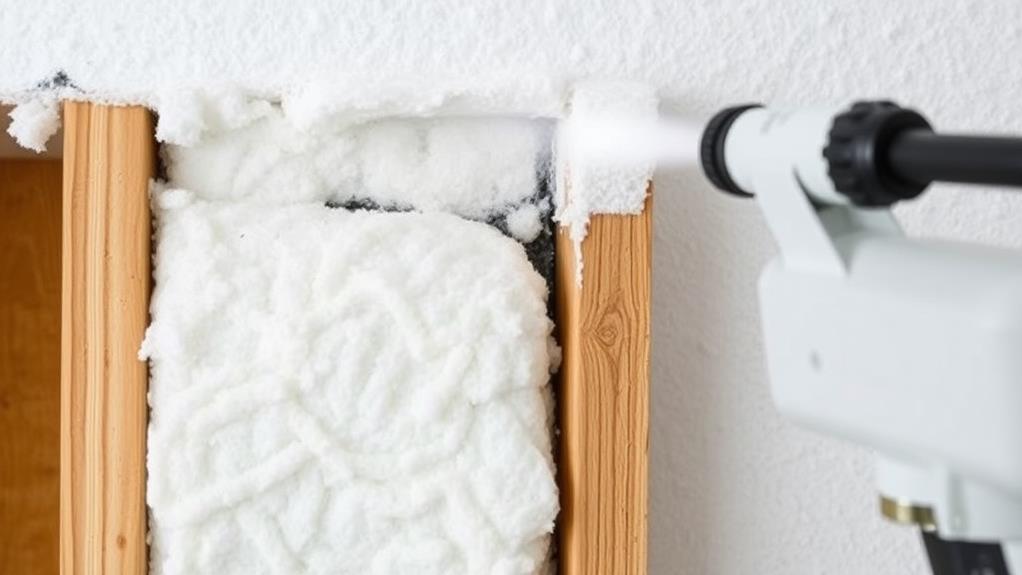
A revolutionary insulation option, spray foam has gained popularity in recent years for its versatility and effectiveness. You'll find two types of spray foam insulation: open-cell and closed-cell. Open-cell foam is lighter and less expensive, while closed-cell foam offers higher R-value per inch and acts as a vapor barrier.
When you choose spray foam, you're opting for excellent air sealing properties. It expands to fill gaps and cracks, creating an airtight barrier that reduces drafts and improves energy efficiency. This can lead to significant savings on your heating and cooling bills.
Spray foam also provides superior moisture control, helping to prevent mold and mildew growth. It's particularly useful in challenging areas like attics, crawl spaces, and irregularly shaped walls. Unlike traditional insulation materials, spray foam won't sag or settle over time, maintaining its performance for years.
However, spray foam insulation is more expensive upfront and requires professional installation. It's not a DIY-friendly option, as it involves specialized equipment and chemicals. Despite the higher initial cost, many homeowners find that the long-term energy savings and improved comfort justify the investment.
R-Value Comparison
Understanding R-value is crucial when comparing insulation materials. R-value measures thermal resistance, indicating how well insulation prevents heat transfer. The higher the R-value, the better the insulation's performance.
Fiberglass batts typically offer R-values between 2.2 and 2.7 per inch, while loose-fill fiberglass ranges from 2.2 to 2.8 per inch. Cellulose insulation provides slightly higher R-values, averaging 3.1 to 3.8 per inch. Spray foam insulation outperforms both, with open-cell foam offering R-values of 3.6 to 3.8 per inch and closed-cell foam reaching 6.0 to 7.0 per inch.
When comparing insulation options, you'll need to consider the total R-value achieved in your wall cavity. A standard 2×4 wall allows for about 3.5 inches of insulation, while a 2×6 wall accommodates 5.5 inches. To meet building codes, you'll often need to achieve a minimum R-value of R-13 for 2×4 walls or R-19 for 2×6 walls.
Remember that factors like proper installation, air sealing, and moisture control also impact insulation effectiveness, so don't rely solely on R-value when making your decision.
Installation Methods and Considerations
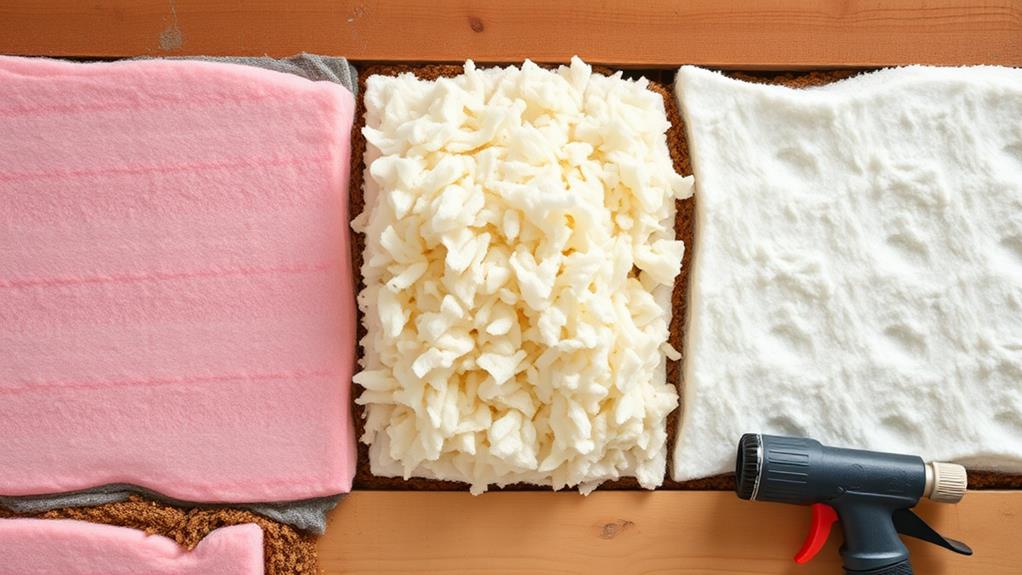
Installation methods for wall insulation vary depending on the material chosen and the stage of construction. For new builds, you'll typically install insulation before the drywall goes up. In existing homes, you'll need to consider retrofitting options.
Fiberglass batts are relatively easy to install. You'll cut them to fit between wall studs and press them into place. Ensure a snug fit without compressing the material, as this reduces its effectiveness.
For loose-fill cellulose, you'll need a blowing machine to install it in enclosed wall cavities. This method works well for retrofitting, as you can drill small holes in the wall to blow in the insulation.
Spray foam requires professional installation due to its complexity and potential health hazards during application. It's sprayed directly onto wall cavities, expanding to fill gaps and create an air seal. This method is ideal for irregularly shaped spaces.
When installing any insulation, consider factors like moisture control, air barriers, and electrical wiring. Proper ventilation is crucial to prevent moisture buildup, which can lead to mold growth. Always wear protective gear and follow safety guidelines, especially when working with fiberglass or spray foam.
Environmental Impact of Insulation Materials
When choosing insulation materials, it's crucial to consider their environmental impact. Fiberglass, cellulose, and spray foam each have different effects on the environment throughout their lifecycle.
Fiberglass insulation is made from recycled glass and sand, which are abundant resources. However, its production requires significant energy and releases greenhouse gases. It's non-biodegradable but can be recycled at the end of its life.
Cellulose insulation is more eco-friendly, made from recycled paper products. It has a low carbon footprint during production and is biodegradable. It also contains borate, which acts as a natural fire retardant and pest deterrent.
Spray foam insulation, while highly effective, has the highest environmental impact. It's made from petroleum-based products and releases harmful chemicals during installation. However, its superior insulating properties can lead to significant energy savings over time.
You should also consider the insulation's longevity and performance. A material that lasts longer and performs better may have a lower overall environmental impact, even if its initial footprint is higher. Additionally, proper installation and disposal methods can greatly reduce the environmental impact of any insulation material you choose.
Cost Analysis and Long-Term Savings
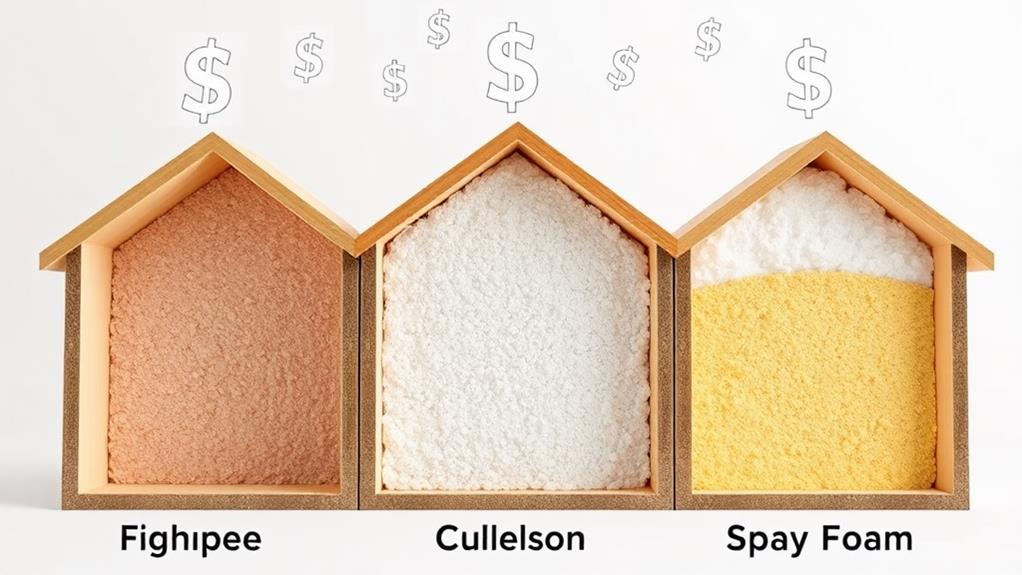
Choosing the right insulation can pay off in the long run, both for your wallet and the environment. When comparing fiberglass, cellulose, and spray foam insulation, you'll find that initial costs vary significantly. Fiberglass is typically the least expensive option upfront, with cellulose falling in the mid-range, and spray foam being the most costly.
However, it's crucial to consider long-term savings. Spray foam, despite its higher initial cost, often provides the best energy efficiency and air sealing properties. This can lead to substantial savings on your energy bills over time.
Cellulose offers good insulation value and is more cost-effective than spray foam, while fiberglass provides decent performance at the lowest price point.
To determine the most cost-effective option for your home, calculate the payback period for each type. Factor in installation costs, energy savings, and potential rebates or tax incentives. Don't forget to consider the lifespan of each material – spray foam and cellulose tend to last longer than fiberglass. By weighing these factors, you'll be able to make an informed decision that balances upfront costs with long-term savings and energy efficiency.
Choosing the Right Insulation Option
Selecting the ideal insulation for your walls involves more than just comparing costs and energy efficiency. You'll need to consider your climate, the age and structure of your home, and local building codes. Start by assessing your home's specific needs.
If you live in a hot, humid area, you'll want insulation with moisture-resistant properties. For colder climates, focus on materials with higher R-values.
Consider your installation preferences. If you're a DIY enthusiast, fiberglass batts might be your best bet. For existing walls, blown-in cellulose or injected foam can be less invasive options. If you're building a new home or doing a major renovation, spray foam offers excellent air sealing properties.
Don't forget about environmental impact. Cellulose, made from recycled paper, is eco-friendly. Fiberglass is also partially recycled, while spray foam has a higher carbon footprint but offers superior insulation.
Lastly, think about long-term performance. Spray foam may cost more upfront but can pay off through energy savings and durability. Fiberglass is budget-friendly but may settle over time, while cellulose offers a good balance of cost and performance.
Conclusion
You've explored the world of wall insulation like Alice in Wonderland, discovering the quirks of fiberglass, cellulose, and spray foam. Each option has its strengths, from R-value to eco-friendliness. Remember, there's no one-size-fits-all solution. Consider your budget, climate, and long-term goals. Whether you're chasing the white rabbit of energy efficiency or the Cheshire cat of cost savings, you'll find the right insulation to make your home a cozy wonderland.
